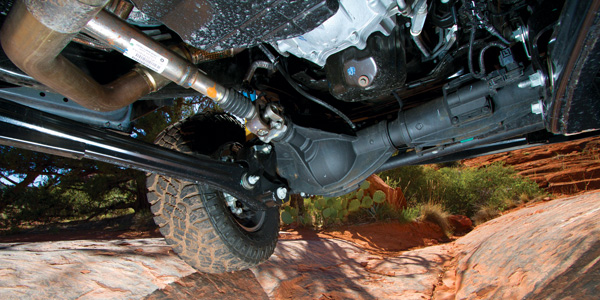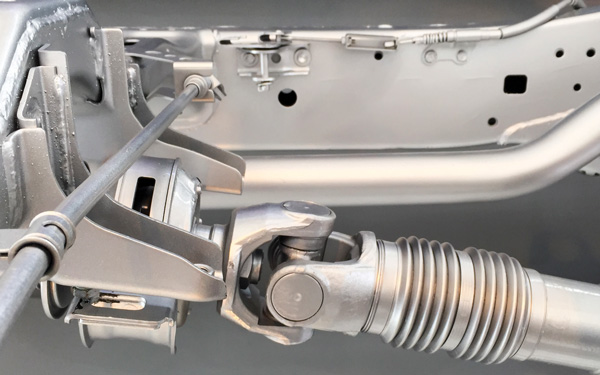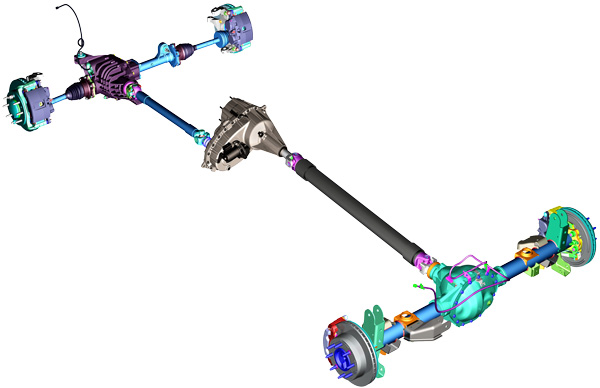
Driveshafts on most rear-wheel-drive and four-wheel-drive (4WD) vehicles are very durable. Most late-model driveshafts are not serviceable and do not have any lubrication points. But, this does not mean that they can’t wear or even fail.
Driveshaft problems can be spotted from the moment you put the vehicle in gear to pull it into a bay. As the power is transmitted from the transmission to the rear axle, the slack from worn or damaged components is taken up, resulting in a sudden crunch or pop.
In SUVs, drivelines come in many configurations due to 2WD and 4WD offerings. On 2WD SUVs, you will find:
- Single shaft with two Cardan universal joints;
- Single shaft with double Cardan on one end and one Cardan on the other end; or
- Split shaft with three Cardan and center carrier.
On 4WD vehicles, you have the above configurations, as well as:
- Front driveshaft with two Cardan universal joints;
- Front shaft with double Cardan on one end and single Cardan on the other end;
- Older 4WD outer half shafts with Cardan universal joints; and
- Newer 4WD with boot-covered constant velocity joints.
Center Support and Carrier Bearing
Center bearings support the driveline when using two or more driveshafts. The center bearing is a ball bearing mounted in a rubber cushion that attaches to a frame crossmember. The manufacturer lubricates and seals the bearing. The cushion allows vertical motion at the driveline and helps isolate the vehicle from vibration.
Premature failure of the center bearing could be the result of too much driveshaft angle, the water shield being missing or damaged, road salt and moisture, or damaged rubber casings. Also, high mileage and bearing wear can contribute to premature wear.
Symptoms of Cardan Universal Joint Problems
There are different things to look for when you suspect universal joint problems:
- The cling and crunch sound when going from drive to reverse with the brake on;
- Rust-colored dust around the universal joint itself;
- With driveshaft removed, any binding in the movement of the universal joint; and
- Vibration on takeoff and vibration on torque.
Servicing the Single and Double Cardan Universal Joint
The first thing to do after the vehicle has been hoisted and the driveshaft has been removed is to mark the yokes for correct phasing, the proper alignment of the inborn yokes. Yokes are the components connected to the driveshaft that allow it to flex (pictured on the center of page 16). If you are working with a split shaft, make sure to mark the shaft prior to splitting the shaft. When securing a shaft in a vise, make sure to clamp around the yoke and not on the hollow tube itself. This eliminates the chance of the hollow tube being damaged if clamped too hard. The best way to remove an old universal joint is to use the proper tools.

After you have installed the new universal joint, make sure it moves freely in all directions.
Diagnosing a double universal joint problem is a little more difficult. This type of joint has many more parts. You will need to check these parts for proper wear:
- Propeller shaft yoke;
- Thrust washers;
- Socket needle bearings;
- Socket ball;
- Link yoke; and
- Other related parts.
When servicing or replacing universal joints, follow the detailed procedure found on your shop’s information system or in the service manual. If you haven’t done one before, have someone help you with the first one.
Driveshaft and Universal Joint Angle
The driveshaft angle on a vehicle with stock suspension and height will probably not be a problem. On a vehicle that has had some form of suspension modification, however, you could run into a problem. When checking the angle, make sure the vehicle’s wheels are on the ground or on a drive-on hoist. Check the angle with proper angle measuring tools. The angle should be in the range of three to eight degrees depending on shaft rpm. The higher the shaft rpm, the lower the degree should be. If the angle is more than this, you may have trouble with vibration and premature joint wear. It is also important to measure the angle of a two-piece shaft.
Universal joints fail for a number of reasons: improper insulation, too much driveline angle, not enough lubricant, moisture and road salt, altered suspension, and bad seals.
Driveline Diagnostics
A small amount of noise is normal when using 4WD on a low-traction surface such as snow, ice, mud or sand. When operated in 4WD on a high-traction surface, such as clear pavement, the noise generated may be much greater. This noise is the result of “driveline loading,” which can naturally occur in 4WD.
As a vehicle travels down the road, the tires rotate a certain number of times per mile depending on the tire circumference. If all the tires are not exactly the same circumference, they will turn at different rates. On these trucks, 4WD is a “part-time” system designed for use only on low-traction surfaces.
This system has no internal differential, so the front and rear propeller shafts will turn at the same speed.
On low-traction surfaces, different tire sizes won’t have much effect, as one tire can easily slip on the road surface to match the speed of the other tires.
On a high-traction surface, it is much more difficult for one tire to slip. Therefore, the 4WD operates under a “blind” to heavy-load condition, and noise is the result.
As tire rolling rates are a major factor in this condition, consider the following important items:
- All tires should be the same size and brand (excluding the spare tire). Tires of different brands may have different circumferences, even if they are the same size;
- Tire pressure is equal in all four tires. A tire with low pressure will roll at a different rate;
- All tires have approximately an equal amount of wear. Tires with different amounts of wear will roll at different rates; and
- Ensure that all tires are the same tread type. Don’t mix on- and off-road, all-season or street tires on the same truck, as they may have different circumferences and roll at different rates.

Driveline noises caused by loading in 4WD vehicles may be mistaken for transfer case or front axle noise because they can sound very similar. 4WD noise caused by loading may exhibit the following conditions:
- The noise will be greatest on a clear, dry road and decrease on a low-traction surface. Front axle or transfer case noise caused by bearing, ring and pinion, or planetary gearing will be the same on all surfaces;
- The noise will increase while making a tight turn. Most front axle or transfer case noises won’t increase;
- The noise can be changed from a deceleration condition to acceleration (or acceleration to deceleration) by raising or lowering tire pressure at one end of the vehicle; or
- One or more of the tires may show small, short scratches around the circumference of the tire tread. These scratches are caused by the tire slipping, or “scuffing,” on the road surface.
This noise should be considered normal and attempting to repair it will not result in satisfactory reductions to driveline noise. Any attempts to correct this condition by repairing these components may cause the customer to believe that the vehicle is unreliable and will also result in an inconvenience while their vehicle is out of service.
Article courtesy Import Car.













